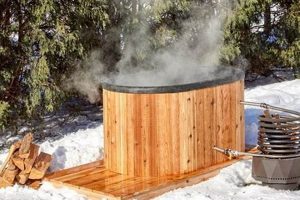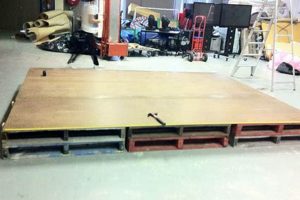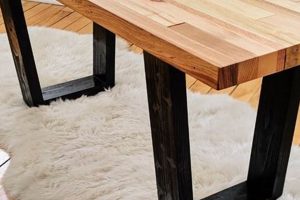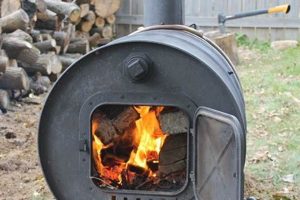Constructing wooden storage units for a kitchen’s dry food area, undertaken as a do-it-yourself project, offers a customized organization solution. These shelving systems, typically crafted from lumber, allow for the tailored arrangement of canned goods, dry ingredients, and other non-perishable food items. A basic example includes a series of horizontal planks secured to vertical supports within an existing pantry closet.
The advantages of this approach are multifaceted. It provides a means to optimize storage space according to individual needs and kitchen dimensions. Furthermore, it can represent a cost-effective alternative to purchasing pre-fabricated units, particularly when reclaimed or repurposed wood is utilized. Historically, homemade shelving has been a prevalent method for managing household provisions, reflecting a tradition of resourcefulness and self-sufficiency.
Therefore, subsequent discussion will focus on essential considerations for such projects, encompassing material selection, design principles, construction techniques, and safety precautions. Attention will also be given to finishing options that enhance durability and aesthetic appeal, along with strategies for maximizing storage efficiency within the completed structure.
DIY Wood Pantry Shelves
Effective implementation of wooden storage within a pantry requires careful planning and execution. The following recommendations address critical aspects of the construction process.
Tip 1: Precise Measurement is Paramount: Accurate measurement of the pantry’s interior dimensions is crucial prior to any material cutting. Allow for adequate clearance around existing structures and potential obstructions. Document all measurements to minimize errors during construction.
Tip 2: Material Selection Impacts Longevity: Choose lumber appropriate for the intended load and environment. Solid wood options, such as pine or oak, offer structural stability. Consider moisture resistance if the pantry is prone to humidity. Plywood provides a cost-effective alternative, but edge banding may be required for a finished appearance.
Tip 3: Shelf Spacing Should Be Optimized: Determine optimal shelf spacing based on the items to be stored. Adjustable shelving systems provide flexibility, but require additional hardware. Standardize shelf heights when possible to streamline storage.
Tip 4: Secure Attachment is Essential for Safety: Shelves must be securely attached to the pantry’s walls or supporting structures. Use appropriate fasteners, such as screws or nails, in conjunction with wood glue. Employ wall anchors when attaching to drywall or plaster.
Tip 5: Finishing Enhances Durability and Aesthetics: Apply a protective finish, such as paint, stain, or varnish, to the completed shelving. This protects the wood from moisture, scratches, and wear. Select a finish that complements the kitchen’s dcor.
Tip 6: Prioritize Load Distribution: Distribute weight evenly across the shelves to prevent sagging or structural failure. Place heavier items on lower shelves and lighter items on upper shelves.
Tip 7: Implement a Leveling System. Ensure all shelves are perfectly level for optimal storage and aesthetic consistency. A spirit level is an essential tool throughout the installation process.
Adherence to these guidelines will contribute to the creation of a durable, functional, and aesthetically pleasing pantry storage solution. The result is improved organization and enhanced kitchen efficiency.
The next section will cover common pitfalls encountered during construction and strategies for effective troubleshooting.
1. Precise Measurements
The success of wooden storage construction within a pantry environment is intrinsically linked to the accuracy of linear dimensions. Dimensional inaccuracies introduce a cascading series of challenges during the fabrication and installation phases. A deviation of even a fraction of an inch can compound across multiple components, leading to misaligned joints, unstable structures, and inefficient use of available space. For instance, if the pantry width is incorrectly measured, shelves may either be too short, rendering them unusable, or too long, necessitating on-site modifications that compromise structural integrity.
The implications of inaccurate measurements extend beyond mere aesthetic concerns. A poorly fitted shelf lacks the support necessary to bear its intended load. The resultant deflection or collapse can damage stored items and pose a safety hazard. Moreover, inaccurate measurements often necessitate costly material waste as incorrectly cut lumber becomes unusable. The cost of replacement materials, coupled with the additional labor required for rework, significantly increases the overall expense of the project. A practical example involves determining the vertical spacing between shelves; inadequate height allowances can prevent taller items from being stored effectively, defeating the purpose of the storage unit.
In conclusion, the importance of precise linear measurements in the context of constructing wooden storage for a pantry cannot be overstated. It functions as a foundational element underpinning the project’s structural integrity, material efficiency, and overall functionality. The adherence to stringent measurement protocols, including the use of calibrated measuring tools and the application of consistent measurement techniques, is essential for achieving a safe, durable, and aesthetically pleasing outcome.
2. Optimal Material Selection
The selection of appropriate materials is a critical determinant in the success of any project focused on creating wooden storage for pantry spaces. Material properties directly influence the structural integrity, longevity, and aesthetic appeal of the shelves.
- Wood Species and Load Capacity
Different wood species possess varying degrees of strength and stiffness, which directly impact the maximum load each shelf can bear without deflection. Hardwoods such as oak or maple offer superior load-bearing capacity compared to softwoods like pine. Selecting a wood species based on the anticipated weight of stored items is crucial to preventing sagging or structural failure. For example, storing heavy canned goods on shelves constructed from low-density softwood may result in significant deformation over time.
- Moisture Resistance and Environmental Factors
Pantry environments can experience fluctuations in humidity, particularly in proximity to kitchens. Certain wood species exhibit greater resistance to moisture absorption and subsequent warping or decay. Cedar, for instance, contains natural oils that inhibit fungal growth and insect infestation, making it a suitable choice for pantries in damp climates. Conversely, untreated pine is more susceptible to moisture damage and may require a protective sealant.
- Material Cost and Project Budget
The cost of lumber varies considerably depending on species, grade, and availability. While hardwoods offer superior performance characteristics, their higher price point may exceed the budget constraints of a do-it-yourself project. Softwoods, plywood, and composite materials represent more economical alternatives, provided their limitations are carefully considered. Balancing material performance with cost-effectiveness is essential for a successful outcome.
- Workability and Ease of Construction
Some wood species are easier to cut, drill, and fasten than others. Softwoods generally require less force to work with hand tools and power tools, simplifying the construction process for individuals with limited experience. Hardwoods, while stronger, demand sharper tools and greater precision. Choosing a material that aligns with the builder’s skill level can significantly reduce the likelihood of errors and improve the overall quality of the finished product. For instance, plywood sheets are easy to cut to size, making them ideal for beginners, although they may require edge banding for a more polished look.
In conclusion, the careful consideration of wood species, moisture resistance, cost, and workability is paramount for creating durable, functional, and aesthetically pleasing wooden storage within a pantry. Proper material selection ensures that the shelving system will withstand the rigors of daily use while remaining within budgetary constraints.
3. Structural Integrity
The sustained performance of wooden storage units in a pantry environment is directly contingent upon its structural integrity. Structural integrity, in this context, denotes the ability of the shelves to withstand applied loads and environmental stresses without deformation or failure. A direct cause-and-effect relationship exists; insufficient structural integrity results in sagging, instability, and eventual collapse, rendering the shelves unusable and potentially causing damage to stored items.
Structural integrity is not merely an abstract concept but a quantifiable attribute directly influenced by design choices and construction techniques. The span between supports, the thickness of the shelf material, and the type of joinery employed all contribute to the overall load-bearing capacity. For instance, a long shelf made of thin plywood lacking intermediate supports will exhibit significant deflection under a moderate load, potentially leading to catastrophic failure. Conversely, a shelf constructed of thicker lumber, supported by vertical dividers, and securely fastened to the pantry walls will maintain its shape and stability even under substantial weight. Another real-life example is using the wrong kind of fastener, such as brad nails instead of screws, to assemble shelf supports. Over time and under load, brad nails can loosen, compromising the stability of the entire unit.
Understanding the interplay between design, materials, and construction is essential for achieving adequate structural integrity. Ignoring these principles creates a functional storage solution that will quickly deteriorate. Prioritizing load distribution, utilizing appropriate fastening methods, and selecting materials with sufficient strength are all critical. In conclusion, a commitment to structural integrity not only guarantees the longevity and utility of the shelving but also mitigates the risk of accidents and property damage. Ensuring stability is not merely an added benefit but a foundational requirement for functional and safe wooden storage in a pantry setting.
4. Customizable Organization
The inherent advantage of undertaking a do-it-yourself wooden pantry shelving project lies in the capacity to tailor the storage solution to precise individual requirements. Unlike prefabricated storage systems with fixed dimensions and predetermined configurations, a custom-built structure allows for the optimization of space based on specific inventory needs. A direct consequence of this customization is increased efficiency in accessing and managing stored items. A standard pantry might feature uniform shelving heights, rendering it unsuitable for accommodating tall cereal boxes or oversized cooking containers. However, through the application of personalized design parameters, shelving can be configured to accommodate varying item heights, minimizing wasted vertical space and improving overall organization.
The absence of customizable organization negatively impacts workflow and efficiency. Without designated areas for specific item categories, the pantry becomes prone to disarray, leading to difficulty in locating necessary ingredients or supplies. This disorganization translates into wasted time and effort during meal preparation. Furthermore, the inability to adapt the shelving configuration as storage needs evolve necessitates frequent reorganizations, which can be both time-consuming and disruptive. Adjustable shelving systems are one example of implementing adaptable organization. By incorporating adjustable shelf standards and brackets, the vertical spacing between shelves can be easily altered to accommodate new items or changing storage requirements.
In conclusion, customizable organization is not merely an aesthetic consideration but a fundamental component of an efficient and functional pantry. Its implementation through projects offers a tangible means of optimizing space, improving accessibility, and streamlining kitchen operations. The ability to tailor the storage configuration to specific needs ensures that the pantry remains a well-organized and productive space, adapting dynamically to evolving storage requirements. Neglecting this aspect often results in a poorly utilized storage area, contributing to inefficiencies in food preparation and management.
5. Enhanced Space Utilization
Effective spatial arrangement within a pantry is paramount for maximizing storage capacity and streamlining kitchen operations. The construction of wooden shelving systems as a do-it-yourself endeavor presents a significant opportunity to optimize available volume, addressing the inherent limitations of pre-fabricated units.
- Vertical Space Optimization
Unused vertical space represents a significant inefficiency in many pantries. Custom-built shelving allows for tailored shelf heights to accommodate specific item dimensions, eliminating wasted headroom. For instance, adjusting shelf spacing to closely fit the height of canned goods or cereal boxes can substantially increase storage density compared to a uniform shelf height configuration.
- Corner and Niche Integration
Pantries often contain awkward corners or alcoves that are poorly utilized by standard shelving units. Do-it-yourself construction facilitates the creation of shelves that precisely fit these irregular spaces, converting previously unusable areas into functional storage zones. This can involve angled shelves, custom-cut units, or specialized corner shelves.
- Adjustable Configuration
Storage needs evolve over time, rendering static shelving configurations increasingly inefficient. A do-it-yourself approach enables the incorporation of adjustable shelving systems, allowing shelf heights to be reconfigured as needed. This adaptability accommodates changes in inventory size or the introduction of new storage containers, ensuring continued optimization of available space.
- Depth Customization
Excessive shelf depth can lead to items being obscured and forgotten at the back. Custom shelving allows for the adjustment of shelf depth to match the size of frequently used items, preventing overstocking and ensuring easy access to all stored goods. Shallow shelves, for example, are well-suited for spices or canned goods, while deeper shelves can accommodate larger appliances or bulk items.
These facets collectively demonstrate how a do-it-yourself wooden shelving project can transcend the limitations of conventional pantry storage. By meticulously addressing vertical space, integrating corner and niche areas, enabling adjustable configurations, and customizing shelf depth, individuals can achieve a significantly more efficient and organized pantry environment.
DIY Wood Pantry Shelves
The following addresses common inquiries regarding the planning, construction, and maintenance of wooden storage structures intended for pantry use.
Question 1: What wood type is best suited for pantry shelving construction?
Optimal lumber choices depend on budgetary constraints, load requirements, and aesthetic preferences. Solid hardwoods such as oak or maple offer superior strength and durability. However, softwoods like pine present a more cost-effective alternative, though their load-bearing capacity is comparatively lower. Plywood offers a balance of affordability and structural integrity, particularly when reinforced with edge banding.
Question 2: How can sagging shelves be prevented?
Preventing shelf deflection necessitates the consideration of several factors. Shorter shelf spans between vertical supports reduce the likelihood of sagging. Increasing the thickness of the shelf material enhances its resistance to bending. Distributing weight evenly across the shelf and avoiding concentrated loads minimizes stress. The addition of a center support or a reinforced edge can provide supplementary support.
Question 3: What are essential safety precautions during construction?
Safety during construction requires the consistent application of precautionary measures. Eye protection is paramount when cutting or sanding wood. Respiratory protection is advisable when working with paints, stains, or adhesives. Securely clamping workpieces prevents movement during cutting or drilling. Power tools necessitate adherence to manufacturer’s instructions and the use of appropriate safety guards. A clean and well-lit workspace reduces the risk of accidents.
Question 4: What type of finish is most appropriate for pantry shelving?
Finish selection should account for durability, cleanability, and aesthetic considerations. Polyurethane provides a durable, water-resistant surface suitable for areas prone to spills. Paint offers a wide range of color options but may require more frequent cleaning. Varnish provides a traditional finish with moderate durability. Food-safe finishes are essential for shelves intended to store unwrapped food items.
Question 5: How is proper ventilation maintained within a pantry?
Maintaining adequate air circulation within a pantry minimizes the risk of mold growth and odor accumulation. Avoid tightly packing shelves to allow for airflow. Consider incorporating ventilation openings into the pantry door or walls. Regularly inspect the pantry for signs of moisture or mildew. Dehumidifiers can be employed in environments with high humidity levels.
Question 6: How can existing pantry shelves be modified to improve organization?
Modifying existing shelving offers a cost-effective means of enhancing organization. Adjustable shelf standards allow for repositioning shelves to accommodate varying item heights. Drawer units provide concealed storage for smaller items. Dividers prevent items from toppling over and maximize space utilization. Door-mounted racks offer additional storage for spices or frequently used items.
In summary, successful wooden shelving construction in a pantry relies on a comprehensive understanding of material properties, structural principles, safety protocols, and organizational strategies. Careful planning and meticulous execution are crucial for achieving a durable, functional, and aesthetically pleasing storage solution.
The subsequent section will provide guidance on troubleshooting common issues encountered during the design and implementation phases of these projects.
Conclusion
The exploration of do-it-yourself wooden storage solutions for pantries reveals a multifaceted undertaking. Material selection, structural integrity, customized organization, and enhanced space utilization have been identified as critical parameters. Adherence to precise measurement protocols and the implementation of appropriate construction techniques directly contribute to the longevity and functionality of the finished product. The absence of careful planning and execution can result in inefficiencies, instability, and potential safety hazards.
The successful implementation of such projects demands a commitment to both aesthetic considerations and practical requirements. Future endeavors should prioritize sustainable material sourcing and innovative design approaches to maximize storage efficiency while minimizing environmental impact. Investing in the creation of durable and well-organized storage solutions represents a tangible investment in household efficiency and resource management. The integration of advanced organizational techniques will continue to improve accessibility and reduce waste in pantry environments.



![[DIY Guide] Easy DIY Wood Window Shutters You Can Build! The DIY Hub: Creative Crafts, Repairs & Life Hacks [DIY Guide] Easy DIY Wood Window Shutters You Can Build! | The DIY Hub: Creative Crafts, Repairs & Life Hacks](https://craftingdiycenter.com/wp-content/uploads/2025/07/th-3579-300x200.jpg)



